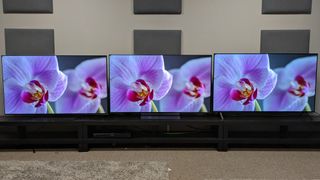Televisions

Televisions have come a long way from the boxy tube-type models of the distant past, and are now thin (incredibly so, in some instances) flat-panels that easily lend themselves to mounting on your wall like a picture.
The two major technologies used for producing televisions are LCD and OLED, with variations on both – LED and mini-LED in the case of LCD, and W-OLED (white) and QD-OLED (quantum dot) for OLED.
Screen sizes for televisions have also evolved to the point where 85-inch TVs are now common and larger sizes such as 88 and 98 inches are available. This development has blurred the distinction somewhat between televisions and projectors, which are used to achieve greater than 100-inch screen sizes in a home theater setting.
Televisions also provide built-in Wi-Fi and smart TV interfaces that can be used for browsing apps and streaming movies and shows. Gaming has also become a primary use for televisions, with recent models providing support for the 4K 120Hz output of next-gen PS5 and Xbox Series X gaming consoles, a feature that provides more realistic graphics and smoother action during gameplay.
While televisions with 8K resolution are available, 4K, which is supported by many streaming services like Netflix, is a more common resolution.
Explore Televisions
Latest about Televisions

Want to know which 2025 LG OLED TV to buy? I tested three models side-by-side, and there's one clear winner
By James Davidson published
I evaluated the G5, C5 and B5 side-by-side to find out which is the best overall value.

Best Buy drops this 43-inch 4K TV to a super-low $99.99 — but not for long
By Jessica Reyes published
As part of its big end-of-year sales, Best Buy has dropped this 43-inch 4K TV to a ridiculously low price of just $99.99.

YouTube's TV app is getting a big makeover with these 5 upgrades
By Carrie Marshall published
The YouTube app for TVs is finally getting a long-promised makeover – here are all the handy improvements.

Move over, Bang & Olufsen: Germany's Loewe is expanding to the US and it's bringing its super-premium OLED TVs
By Carrie Marshall published
Loewe's high-end OLEDs include some very striking designs and unusual materials

LG StanByME 2 review: a versatile TV that’s way more useful than I expected
By Max Langridge published
The LG StanByMe 2 is a unique TV proposition and I wasn't sure I'd find a need for it at home – how wrong I was.

JMGO’s new, feature-packed portable 4K projector is surprisingly cheap — but only for a limited time
By Carrie Marshall published
JMGO's short-throw projector is very bright and comes packed with features

The best 55-inch 4K TVs for all budgets, all tested by our experts
By Matt Bolton last updated
Updated Don't settle for less than the best 55-inch 4K TVs, with great pictures, upscaling, interfaces, and audio all in one brilliant package.

These five 4K Blu-rays are so good, they've entered my TV testing rotation
By James Davidson published
As a TV reviewer, it's good to update the 4K Blu-rays I use for testing. These 5 discs are the latest additions.
Sign up for breaking news, reviews, opinion, top tech deals, and more.

